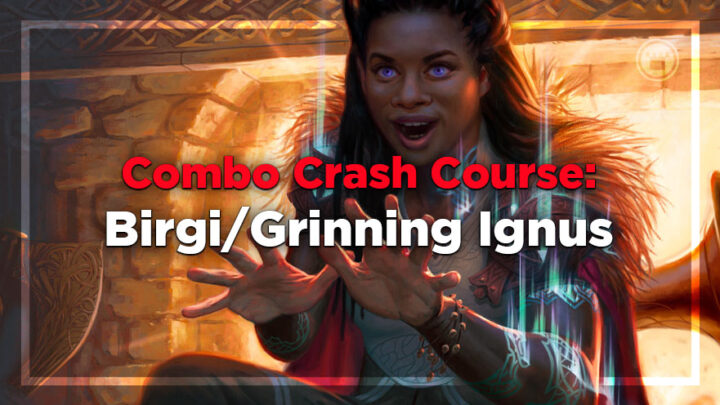There’s a lot of two-card combos in Magic, but the best ones often come from way back in the game’s history.
To a degree, that’s just statistics – the number of unique cards printed over the last 29 years is just so much larger than the pool of Standard-legal cards at any given point. This means that the combos we look at for Combo Crash Course would involve one or more cards from an older era.
Besides that number advantage, we also have to assume R&D spends far more time and effort checking new cards for broken combo potential within their own Standard, compared to a possible combo which only exists in Vintage. So with the exception of a few intensely obtuse and convoluted combos (like the recent Lore Drakkis/Goldspan Dragon deck) we can safely assume any combo that turns up in the Standard metagame was balanced deliberately for that purpose. And if wasn’t balanced well, we find that out pretty quick.
And so I find it astonishing that we’ve had access to one of the most efficient, flexible, realistic two-card combos ever allowed into Standard – for almost a year – and it still hasn’t made an impact. This combo also has unrealized potential to consider in Historic, in Pioneer, even Commander!
So, while we’re still in this special window of opportunity, let’s talk about the Grinning God infinite. And in doing so, let’s talk about how to evaluate a combo’s competitive power level.
WHAT IS THE GRINNING GOD INFINITE?
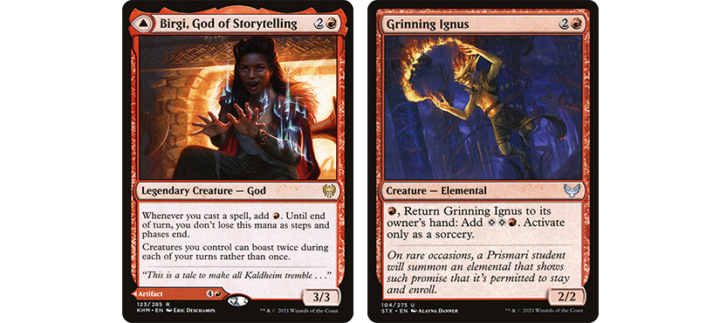
What I’ve dubbed “the Grinning God infinite” is an exciting bit of synergy between Grinning Ignus and Birgi, God of Storytelling. Ignus has an activated ability which lets it bounce between hand and battlefield at the net cost of just one red mana per loop. But with Birgi in play an extra red mana is created each time Ignus is cast, allowing you to sustainably play (and return) Ignus as many times as you want during your own main phases.
WAIT, IS THAT ACTUALLY GOOD?
“Exciting” is always a high bar to clear when it comes to tournament Constructed, but there’s a lot going for this specific duo for even the least generous critic! Most uniquely right now, they’re both legal in Standard (Ignus was reprinted in Strixhaven, Birgi debuted in Kaldheim). They’re both the same color too, which makes it even easier to build around them in a variety of ways.
They’re both three mana creatures which can be utilized outside the combo for blocking or other general purposes, a luxury many combo decks don’t have. This also means that both parts are hits off Collected Company – a trait which has predicted much success for creature combo lists in the past. Creature cards benefit from being relatively easy to tutor for or even reanimate.
Best of all for the Commander players out there, Birgi is legendary – you can easily build a Commander deck whose main plan is establishing this loop, where the more powerful half is always available in the Command Zone. Again, this is a classic trait of successful decks in EDH.
And while I have to admit that these two cards don’t actually end the game by themselves, there are so many ways to profit off the infinite loop with a third card that it feels like an afterthought.
Any additional effect which reduces the mana cost of casting and replaying Ignus will let you generate infinite mana from the loop. You can also generate infinite triggers off any card that cares about creatures entering or leaving the battlefield. Of course you’re casting infinitely many spells as you go off, which can also help find wins with triggers, or in older formats, an arbitrarily large Grapeshot.
HOW TO BEAT IT?
Despite all the upside we just discussed, this combo has now been around a full year and only caused the barest ripple in the metagame. So there must also be some downside to this Grinning God infinite. Needing another card to close the game is definitely a mark against it, even if the possibilities for the third card are very broad.
The biggest issue is vulnerability to interaction. Spot removal or counterspells for either creature will shut things down very quickly if the opponent has it ready. Unlike most successful combos which involve creatures, neither of our cards benefit from defensive keywords like Flash or Hexproof. Grinning Ignus in particular is a 2/2 sitting duck, killed by almost anything and unable to activate its ability at instant speed to dodge targeted effects.
Sequencing the Grinning God infinite is also more of a stretch on your mana than one might think. Both Birgi and Ignus costing exactly three might help out with effects like Collected Company, but it does make casting them normally more difficult. Because we need to play two different spells after reaching three mana, deploying the combo in a timely fashion demands that you always make your first three land drops on time.
But our old friend the hypergeometric calculator reminds us that you’ll miss a land roughly one in four games when going first with a 23-land deck. If you end up with Ignus in play before Birgi, then you’ll need to hit a 4th land drop to start the combo – or leave your pair of prized creatures hanging for an extra turn. With up to a 40% fail rate on the play. And that’s before you consider the complications of lands entering tapped, or wanting to have something like Duress or Spell Pierce to protect your final turn. Yes, all this is a part of playing combo decks (and Magic more generally). But it’s still a small weakness which undermines the chances for Grinning God to become a top-tier deck.
Lastly, there’s a certain lack of redundancy holding the combo back. Grinning Ignus in particular is in a class of its own when it comes to refunding itself AND recurring itself. While Birgi can be substituted for other spell-discounting cards, the only real way to make the Ignus side more consistent is to play tutors for Ignus.
At least this weakness is one opponents might struggle to exploit further – both combo pieces being creatures means they avoid getting picked off by Duress or Test of Talents. But a single Lost Legacy or Necromentia could spell real problems for a dedicated Grinning God combo deck.
HOW (AND WHERE) TO PLAY IT?
We’ve just laid out the thesis for a potential combo deck, but what we really need is some proof-of-concept! Luckily we can consider our options across the full range of supported Constructed formats, since these cards are legal everywhere but Pauper. I already mentioned that Birgi’s status as a cheap, combo-enabling legendary creature makes her a powerful commander choice, even at the highest levels of competition. Then there’s Historic, where the Grinning God combo has seen its most significant patch of play so far, breaking into December’s Innistrad Set Championship.
But as a general rule, when a combo happens to be Standard-legal that’s the first place to look for success, since the competition is generally weaker and you can usually tell quite quickly which deck ideas will give you a real shot. In our case the #1 best hope of making the Grinning God loop a game winner is Showdown of the Skalds, which is what this player was using to rack up wins on Arena.
Showdown ticks every box we could ask of our “third card” for the combo. It lets us convert the loop into infinite damage with an unblocked attacker, thanks to the triggers from its second and third chapters. But it doubles as a powerful and oh-so-necessary draw spell, helping us dig deeper into our library and find our missing combo pieces quickly. Lastly, that amount of raw power lets us play a fair midrange game and still compete, which helps given the fragility of our combo. This way, just going all-in on stopping Birgi and Ignus will get incautious foes slapped down by the might of skalds and dragons!
The deck can draw so many cards that eventually you *will* force through some kind of relevant boardstate.
There are a few other cards which I’d be interested to test if I were to play a deck like this myself, especially if I wanted a more combo-focused version. In particular, Moonveil Regent seems like an absolute must-have if you’re going to run a few dragons.
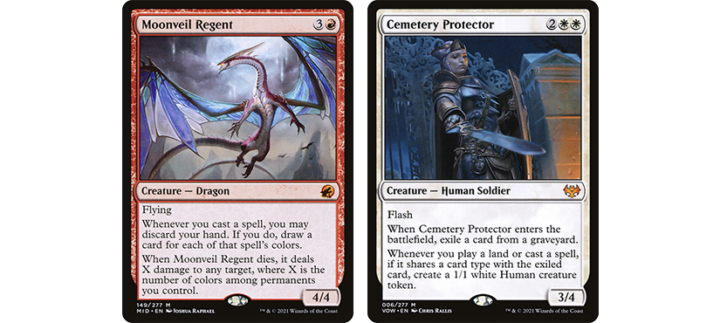
Regent won’t immediately generate a win from the combo, but if you have it around you’ll be able to draw as many cards as you need by recasting Ignus. Which is usually lethal. And the upside is a well-costed flyer for our midrange plan, as well as a card which generates meaningful value from Ignus even without Birgi around. Cemetery Protector falls along the same lines, creating infinite 1/1s with the full combo or merely lots of them with Ignus alone. And it has Flash, which makes assembling a winning board more realistic even against control decks.
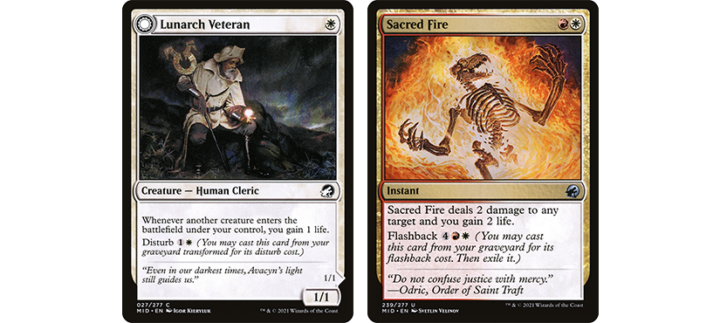
Lunarch Veteran isn’t quite on the same level, but it does generate infinite life from the loop regardless of which side it’s on. The flying on its disturbed side carries +1/+1 counters from Showdown well, and just by running Disturb or Flashback cards you’ll often have fuel for your various on-cast triggers in spots you otherwise wouldn’t.
GRIN AND BEAR IT
There’s a reason why new great combo decks don’t come around often, and it’s not just because of R&D restricting the archetype. Trying to build and tune these decks can be harder than basically any other style in Magic – you have to look past the obvious best cards, do a lot of your own research, and be willing to admit when you’ve sunk far too many hours into a wrong-headed line of thought. But if you succeed in breaking it, you’ll be able to claim the unique credit of singlehandedly disrupting the global metagame; perhaps you’ll even spike a tournament or two before people catch up!
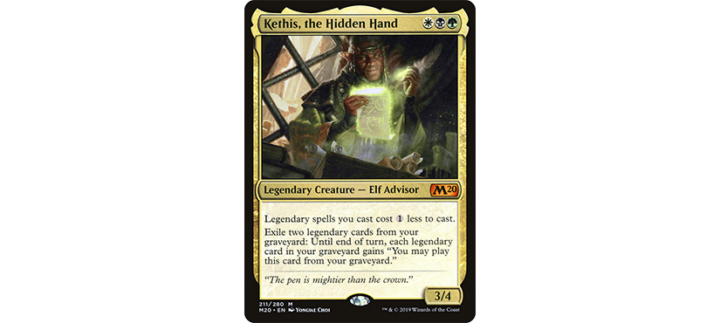
So will this Grinning God loop be the next big thing? It feels good to play around with, but solving for the ultimate version of this deck in Standard, Pioneer, or Modern is a puzzle players have universally rejected for the past year. There’s definitely an exciting and playable deck to be had with these overlapping synergies, but can it exceed those expectations and beat the best? It might be one of us that has to find out…

Tom’s fate was sealed in 7th grade when his friend lent him a pile of commons to play Magic. He quickly picked up Boros and Orzhov decks in Ravnica block and has remained a staunch white magician ever since. A fan of all Constructed formats, he enjoys studying the history of the tournament meta. He specializes in midrange decks, especially Death & Taxes and Martyr Proc. One day, he swears he will win an MCQ with Evershrike. Ask him how at @AWanderingBard, or watch him stream Magic at twitch.tv/TheWanderingBard.

